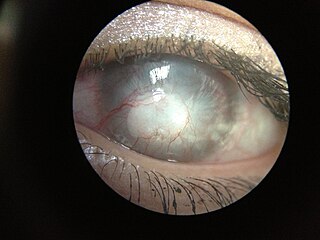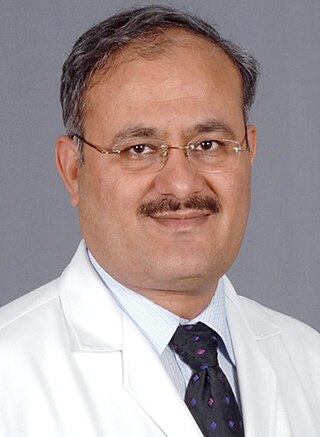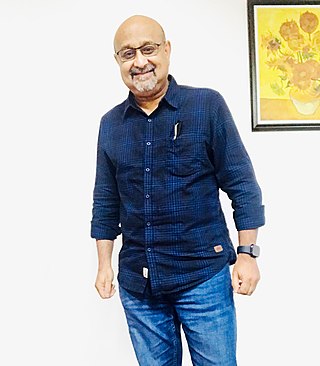
In multicellular organisms, stem cells are undifferentiated or partially differentiated cells that can change into various types of cells and proliferate indefinitely to produce more of the same stem cell. They are the earliest type of cell in a cell lineage. They are found in both embryonic and adult organisms, but they have slightly different properties in each. They are usually distinguished from progenitor cells, which cannot divide indefinitely, and precursor or blast cells, which are usually committed to differentiating into one cell type.

The cornea is the transparent front part of the eye that covers the iris, pupil, and anterior chamber. Along with the anterior chamber and lens, the cornea refracts light, accounting for approximately two-thirds of the eye's total optical power. In humans, the refractive power of the cornea is approximately 43 dioptres. The cornea can be reshaped by surgical procedures such as LASIK.

Sankara Nethralaya is a non-profit missionary institution for ophthalmic care headquartered in Chennai, India.

Acanthamoeba keratitis (AK) is a rare disease in which amoebae of the genus Acanthamoeba invade the clear portion of the front (cornea) of the eye. It affects roughly 100 people in the United States each year. Acanthamoeba are protozoa found nearly ubiquitously in soil and water and can cause infections of the skin, eyes, and central nervous system.

Corneal neovascularization (CNV) is the in-growth of new blood vessels from the pericorneal plexus into avascular corneal tissue as a result of oxygen deprivation. Maintaining avascularity of the corneal stroma is an important aspect of healthy corneal physiology as it is required for corneal transparency and optimal vision. A decrease in corneal transparency causes visual acuity deterioration. Corneal tissue is avascular in nature and the presence of vascularization, which can be deep or superficial, is always pathologically related.

Macular corneal dystrophy, also known as Fehr corneal dystrophy, is a rare pathological condition affecting the stroma of cornea first described by Arthur Groenouw in 1890. Signs are usually noticed in the first decade of life and progress afterwards, with opacities developing in the cornea and attacks of pain. This gradual opacification leads to visual impairment often requiring keratoplasty in the later decades of life.

Boston keratoprosthesis is a collar button design keratoprosthesis or artificial cornea. It is composed of a front plate with a stem, which houses the optical portion of the device, a back plate and a titanium locking c-ring. It is available in type I and type II formats. The type I design is used much more frequently than the type II which is reserved for severe end stage dry eye conditions and is similar to the type I except it has a 2 mm anterior nub designed to penetrate through a tarsorrhaphy. The type I format will be discussed here as it is more commonly used.

Herpetic simplex keratitis is a form of keratitis caused by recurrent herpes simplex virus (HSV) infection in the cornea.
Sheraz Daya is a British ophthalmologist. Daya founded the Centre for Sight in 1996, and works in stem-cell research and sight restoration and correction surgery.

Reza Dana is the Claes H. Dohlman Professor of Ophthalmology, senior scientist and W. Clement Stone Clinical Research Scholar at Massachusetts Eye and Ear, Harvard Medical School, and director of the Harvard-Vision Clinical Scientist Development Program.
Jeewan Singh Titiyal is an Indian ophthalmologist, credited with the first live cornea transplant surgery by an Indian doctor. He was honoured by the Government of India, in 2014, by bestowing on him the Padma Shri, the fourth highest civilian award, for his services to the field of medicine.
Mooren's ulcer is a rare idiopathic ocular disorder that may lead to blindness due to progressive destruction of the peripheral cornea. Although the etiology of Mooren's ulcer is poorly understood, recent evidence suggests that the pathogenesis of this disease appears to be the result of an autoimmune process directed against molecules expressed in the corneal stroma.

Limbal stem cells, also known as corneal epithelial stem cells, are unipotent stem cells located in the basal epithelial layer of the corneal limbus. They form the border between the cornea and the sclera. Characteristics of limbal stem cells include a slow turnover rate, high proliferative potential, clonogenicity, expression of stem cell markers, as well as the ability to regenerate the entire corneal epithelium. Limbal stem cell proliferation has the role of maintaining the cornea; for example, by replacing cells that are lost via tears. Additionally, these cells also prevent the conjunctival epithelial cells from migrating onto the surface of the cornea.

Dr. Vijay Anand Reddy is an Indian oncologist known for his contributions to the field of cancer. He serves as the director and senior consultant oncologist at Apollo Cancer Hospital, Hyderabad. He also served as the President of Association of Radiation Oncologists of India & Chairman of Indian College of Radiation Oncology.

Virender Singh Sangwan is an Indian ophthalmologist and the Dr. Paul Dubord Chair professor and director of the L. V. Prasad Eye Institute, Hyderabad. Known for his research on limbal stem cells, Sangwan is the founder secretary and an adviser of the Uveitis Society of India. The Council of Scientific and Industrial Research, the apex agency of the Government of India for scientific research, awarded him the Shanti Swarup Bhatnagar Prize for Science and Technology, one of the highest Indian science awards for his contributions to Medical Sciences in 2006.

Madhavan Radhakrishna Pillai is an Indian cancer biologist and the former director of the Rajiv Gandhi Centre for Biotechnology. Known for his studies on papilloma viruses, Pillai is an elected fellow of the Indian Academy of Sciences, National Academy of Sciences, India, Royal College of Pathologists and the National Academy of Medical Sciences. The Department of Biotechnology of the Government of India awarded him the National Bioscience Award for Career Development, one of the highest Indian science awards, for his contributions to biosciences in 2002.
Aditya Bhushan Pant is an Indian toxicologist, neurobiologist and a scientist at the Indian Institute of Toxicology Research. He is known for his studies in the fields of developmental toxicology, in vitro experiments as well as pesticides and is a member of the Neurobiology Task force of the Department of Biotechnology. His studies have been documented by way of a number of articles and ResearchGate, an online repository of scientific articles has listed 121 of them. Besides, he has contributed chapters to books published by others and is an associate editor of the Annals of Neurosciences journal of the Indian Academy of Neurosciences. He is a recipient for the Shakuntala Amir Chand Prize of the Indian Council of Medical Research in 2007. The Department of Biotechnology of the Government of India awarded him the National Bioscience Award for Career Development, one of the highest Indian science awards, for his contributions to biosciences, in 2012.

Graziella Pellegrini is an Italian Professor of Cell Biology and the Cell Therapy Program Coordinator at the University of Modena and Reggio Emilia. She has developed and championed cell therapy protocols in hospitals across Italy.
Peripheral Ulcerative Keratitis (PUK) is a group of destructive inflammatory diseases involving the peripheral cornea in human eyes. The symptoms of PUK include pain, redness of the eyeball, photophobia, and decreased vision accompanied by distinctive signs of crescent-shaped damage of the cornea. The causes of this disease are broad, ranging from injuries, contamination of contact lenses, to association with other systemic conditions. PUK is associated with different ocular and systemic diseases. Mooren's ulcer is a common form of PUK. The majority of PUK is mediated by local or systemic immunological processes, which can lead to inflammation and eventually tissue damage. Standard PUK diagnostic test involves reviewing the medical history and a completing physical examinations. Two major treatments are the use of medications such as corticosteroids or other immunosuppressive agents and surgical resection of the conjunctiva. The prognosis of PUK is unclear with one study providing potential complications. PUK is a rare condition with an estimated incidence of 3 per million annually.

Stem cell therapy for macular degeneration is an emerging treatment approach aimed at restoring vision in individuals suffering from various forms of macular degeneration, particularly age-related macular degeneration (AMD). This therapy involves the transplantation of stem cells into the retina to replace damaged or lost retinal pigment epithelium (RPE) and photoreceptor cells, which are critical for central vision. Clinical trials have shown promise in stabilizing or improving visual function, but are nevertheless inefficient.















